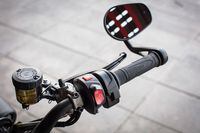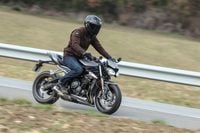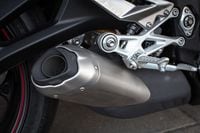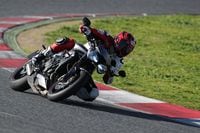Quick, name three things you don't like about the current generation (2013-16) Triumph Street Triple. It's no easy task, right? I can only think of one. And therein lies the challenge for manufacturers when updating popular, well-built machines. Triumph went through this recently with the hugely successful Bonneville lineup, and it faced the same challenge when updating the Street Triple. How do you make a good bike better without screwing it up?
WHAT’S NEW IN 2017
First, leave the good stuff alone—and that’s just what Triumph did. Ergonomics, for one, are much the same, meaning basically the perfect combination of short reach to a flat handlebar and a compact rider triangle. The Street feels sporty and purposeful without being overcommitted, even for me at 6-foot-2. The 366-pound claimed weight is probably a little ambitious: a last-gen Street tipped our scales at 414 pounds, and Triumph says the new Street is 2 kilos lighter in 2017. So, we think 410 pounds is a realistic expectation for the new bike. To put that in context, that would make it just 10 pounds heavier than a fully-fueled Yamaha FZ-07. Impressive.
Most of the weight savings for 2017 come from a new exhaust, which is 1.7 kg lighter than last year. There’s also a new swingarm (slightly longer for 2017), frame, fresh body panels and suspension components, plus a new dash that raises the game not just in this category but across motorcycling. Around this point you might be wondering why (other than the obvious potential boon in showroom appeal) Triumph would spend all of this time and money on expanding and improving the Street Triple lineup. One particular statistic answers that question: 50,000. As in the number of Streets that Triumph has sold over the past ten years. That’s a major success for the gang in Hinckley, and clearly the goal is to boost the Street into the limelight as the massive success it has become.
So, more power is always good, right? The big news in the engine department is a bump in displacement from 675cc to 765cc, by adding 2mm of bore and 3.8mm of stroke to the engine from the Daytona 675 (rather than the previous generation Street Triple unit). Chief Engineer Stuart Wood explained that one of the main goals with the new Street was to get more from the engine without making it physically larger on the outside, and that’s exactly what Triumph did: same package size, more power and torque (we should all be so lucky). The new Street’s bigger cylinders are Nikasil-plated aluminum, instead of the iron sleeves from the previous generation, and they work in tandem with around 80 other new parts in the engine, including new pistons, connecting rods, and a revised crank.
Getting into the specifics of the valvetrain, suspension, and electronics is where it gets tricky. The new Street Triple family is comprised of three basic models—the base-model S, mid-line R, and top-spec RS—each of which offer a different combination of suspension and brake components, ride modes, intakes and cams, and dash display options. Interestingly, the S and RS share cams even though the state of tune is different. The RS claims 121 hp at 11,750 rpm and 57 pound-feet of torque at 10,800 rpm. (Check out the photos/captions for specific breakdowns of options, and read our First Look of the Street family HERE. I can't speak for the S or R versions, because my test was contained to one day—a morning riding the foothills north of Barcelona and the afternoon carving through corners at Circuit de Barcelona-Catalunya on the top-of-the-line RS.
Striding up to the 2017 Street Triple RS on a chilly and wet Spanish morning, the styling updates are subtle. It very much looks like an evolution of the previous Street rather than an all-new machine. I say that’s a good thing. It’s a handsome bike, with a threatening squint in the headlight shape and a slender chassis. Once perched in the 32.5-inch high saddle with the key on, there’s only one thing you’ll be able to see: The 5-inch TFT dash on the new Street Triple comes to life calmly but immediately steals your attention. This was my one complaint about the old bike, and boy did Triumph ever fix it. I can’t go into all of the detail necessary to describe the multitude of options that this new system puts in the rider’s hands because you’d be bored to death. Check out the quick video below or go to a showroom and ask to test the dash—it may be the best display and interface in motorcycling.
This dash would be the best part of a lot of other motorcycles, but the Street has plenty more to offer. Triumph went to a lot of trouble to enhance the Street’s three-cylinder growl, and it’s noticeable right out of the parking lot. The new engine has a very familiar tenor, and what seems like even more intake howl when you really twist the grip. It doesn’t feel to me as though it has quite the same brawny stomp as Yamaha’s FZ-09, but remember that even with the displacement bump the Street still gives up 82cc to the Fuzz-9, plus the RS I rode is tuned for top-end power. Also, something the Yamaha can’t claim (though I haven’t ridden the 2017 FZ-09) is absolutely flawless fueling—it has been a Triumph trademark since cables controlled the throttle and it’s alive and well in the ride-by-wire era.
The RS model has five ride modes available—Road, Rain, Sport, Track, and “Rider,” which is programmable to your favorite settings and selectable from the menu. Modes set different parameters for throttle map (Road, Rain, or Sport), Continental ABS (Road or Track), and Triumph Traction Control (Road, Rain, Sport, or Track). Each of the three throttle maps deliver all of the engine’s power (121 claimed horses in the case of the RS) eventually, just at different rates. Having a choice in maps is nice, but truthfully the Street Triple doesn’t need it—Sport mode is perfectly easy to use and left me without a use for the others. Track ABS allows more discrepancy in front- and rear-wheel speeds while Road is obviously more conservative. As for TTC, I hardly noticed it except when it kicked in to keep the front wheel on the ground (Track mode doesn’t do that). Arguably the best feature is that ABS and TTC can be switched off if you so desire, right from the dashboard: no need to pull a fuse.
The first couple of hours in the saddle of the Street Triple saw rainy and dirty roads, so didn’t leave me much room to experiment with RS’s up-spec and fully adjustable Ohlins shock and Showa Big Piston Fork. I can tell you the suspension is taught, for sure. Not overly stiff, but it’s a light bike and there’s a definite emphasis on sport riding. Weaving down out of the mountains toward the Catalunya circuit just before lunch, the roads dried out and I could lean into the Pirelli Supercorsa SP rubber a little bit. No surprise, the Street handles impeccably—a lot like you might expect from a 400-pound machine with a few thousand dollars of suspension components bolted to it. And the brakes? The Panigale-spec M50 Brembos responded with endless power and excellent feel to anything I threw at them, then basically yawned back at me. These binders are overkill on this bike, and I approve.
So many of the little things go unnoticed on the Street, too. After a half day of riding I realized I hadn’t even considered the seat—a sure sign that it’s comfortable, even though it feels stiff. The RS’s standard bar-end mirrors are borrowed from the flagship Speed Triple, and work amazingly well while keeping the Street’s profile aggressive and sharp. A standard quickshifter, a $350 accessory on the S and R, allows for clutchless upshifts (there’s no auto-blip downshift function) and works as expected. I will say, it’s not as buttery smooth as some other systems, but it beats clutchin’! Lastly, I was thankful for the heated grips, a $215 option on all bikes, which delivered to my chilly hands three levels of heat controlled by a tidy button on the left grip.
After a cold but leisurely morning of switching between ride modes and playing with the dash as I wound my way through quaint Catalan towns, the sun broke out and warmed up the Circuit de Barcelona just in time for some fast laps. With dry pavement and knee pucks in place I could test the Street Triple’s mettle at steep lean angles, triple-digit speeds, and heavy braking. The same suspension that had seemed stiff on the street actually felt a tad soft on track, which I think says Triumph nailed the compromise. If you’re disappointed to hear that because you’re hot for a Street Triple and don’t want to take it to the track, all I can say is that you should.
The RS is tuned for peak power, and above 9,000 rpm is where this new RS engine really separates itself from the outgoing model. It’s smooth and composed on the street, but needs to be wrung out to truly be appreciated. The track ABS setting, combined with the slip/grip clutch, allows enough rear-brake drag to slide pretty dramatically into corners. Then again, I found the ABS a little intrusive at the end of the kilometer-long front straight when braking from 150 mph. A few flicks of the joystick and ABS was off, which I would recommend for advanced track riders.
Every other aspect of the bike was completely ready for track use—from the grippy footpegs to the powerful brakes and taught suspension. I could have railed around Catalunya all day and never been bored. The bike is a gem on the track. I routinely ran the bike out onto the grippy, GP rumble strips with sportbike precision and laughed out loud in my helmet. This is a seriously legitimate naked bike, full of technology and built to the highest standard. Yes, 765cc makes it a middleweight in today’s market, but in terms of versatility and performance from apex to apex, this is a world-class machine.
There is, arguably, a catch. It’s easy to compare the base-model S, which starts at $9,900, to Yamaha’s FZ-09. The S also has a simpler dash, two (of the possible five) ride modes, sliding pin brakes, less power, and fewer amenities. By the time you get to the top of the line, it’ll be $12,500 to roll out of a Triumph dealer on the RS that I rode (a little more depending on paint, plus the heated grips I enjoyed). That’s only a few hundred bucks shy of a minty fresh Yamaha FZ-10 or Ducati Hypermotard 939. Fast company, any way you slice it.
Still, what Triumph have done is commendable. The Street Triple has become a pillar of the British firm’s revenue and success and, just like it did with the Bonneville, Triumph has poured extra effort into making the Street Triple lineup bigger than ever. In addition to the S, R, and RS models, there is also slated to be a Low Ride Height (LRH) version of the R, with a 30.7-inch seat height via unique suspension components. Across the pond there will be a 660cc “A2” version, limited to 47 hp, specifically designed for the tiered Euro license system.
I’ll admit I’ve only ridden one slice of the Street Triple lineup. But, as far as I can tell Triumph have done it again—a good bike has been made better.


























/cloudfront-us-east-1.images.arcpublishing.com/octane/IIGGWFOTOJGB7DB6DGBXCCMTDY.jpg)
/cloudfront-us-east-1.images.arcpublishing.com/octane/QSTCM6AVEZA5JJBUXNIQ3DSOF4.jpg)
/cloudfront-us-east-1.images.arcpublishing.com/octane/U4I7G625B5DMLF2DVIJDFZVV6M.jpg)
/cloudfront-us-east-1.images.arcpublishing.com/octane/B6XD6LS6IVCQPIU6HXDJSM3FHY.jpg)
/cloudfront-us-east-1.images.arcpublishing.com/octane/ICL63FEDDRDTTMINYICCEYGMDA.jpg)
/cloudfront-us-east-1.images.arcpublishing.com/octane/FCGZHQXRBZFLBAPC5SDIQLVF4I.jpg)
/cloudfront-us-east-1.images.arcpublishing.com/octane/WNOB6LDOIFFHJKPSVIWDYUGOPM.jpg)

/cloudfront-us-east-1.images.arcpublishing.com/octane/X33NU3E525ECRHXLNUJN2FTRKI.jpg)
/cloudfront-us-east-1.images.arcpublishing.com/octane/6KKT5NNL2JAVBOXMZYS5ZO76YA.jpg)
/cloudfront-us-east-1.images.arcpublishing.com/octane/J5RKG5O455GMPGQRF2OG6LRT7A.jpg)
/cloudfront-us-east-1.images.arcpublishing.com/octane/GX2CIZKQVRH2TATDM26KFG2DAE.jpg)
/cloudfront-us-east-1.images.arcpublishing.com/octane/ZWIDYSAKQZHD5BHREMQILXJCGM.jpg)
/cloudfront-us-east-1.images.arcpublishing.com/octane/CYUHJZCTSJCH3MRAQEIKXK7SCQ.jpg)
/cloudfront-us-east-1.images.arcpublishing.com/octane/LKOFINY56FCXJCANJ5M7ZDQUBY.jpg)
/cloudfront-us-east-1.images.arcpublishing.com/octane/4NBPDACMWJH63JQYJVK3QRBDZI.jpg)
/cloudfront-us-east-1.images.arcpublishing.com/octane/KKHQHRR3FJGX7H2IPU6RALMWG4.jpg)

/cloudfront-us-east-1.images.arcpublishing.com/octane/5IOFS5JAE5FOXMNA23ZRAVVYUU.jpg)
/cloudfront-us-east-1.images.arcpublishing.com/octane/CGXQ3O2VVJF7PGTYR3QICTLDLM.jpg)

/cloudfront-us-east-1.images.arcpublishing.com/octane/OQVCJOABCFC5NBEF2KIGRCV3XA.jpg)
/cloudfront-us-east-1.images.arcpublishing.com/octane/OPVQ7R4EFNCLRDPSQT4FBZCS2A.jpg)
/cloudfront-us-east-1.images.arcpublishing.com/octane/YBPFZBTAS5FJJBKOWC57QGEFDM.jpg)